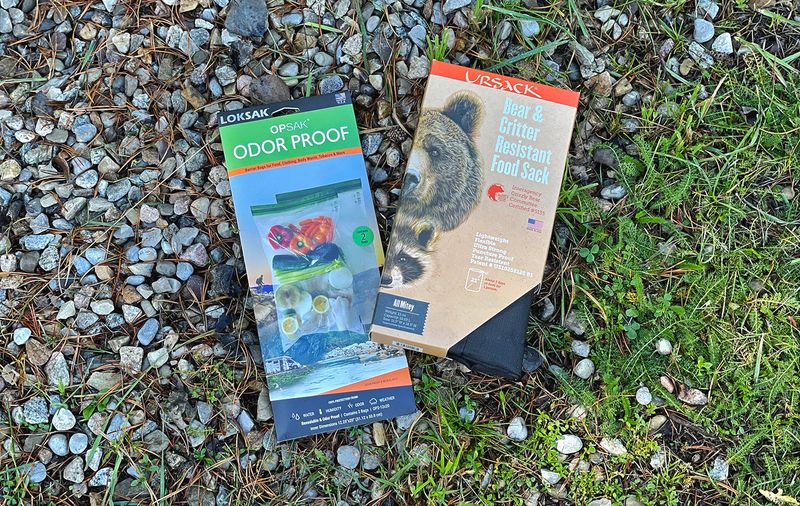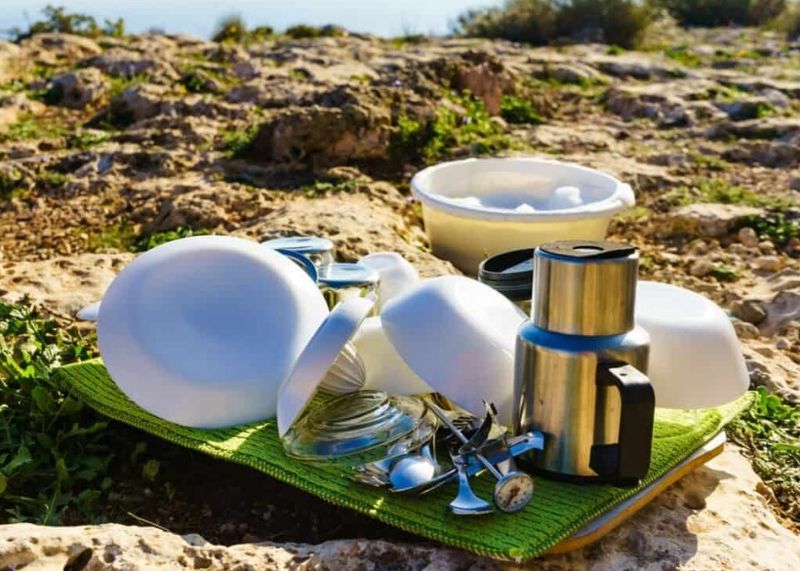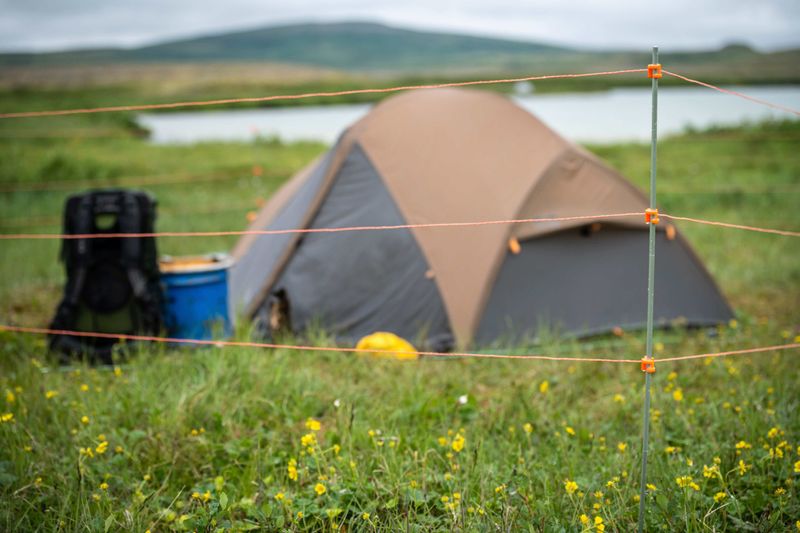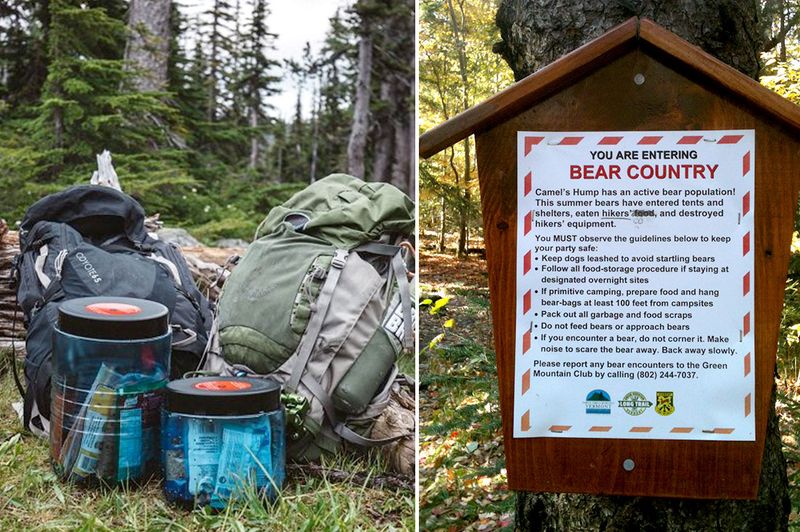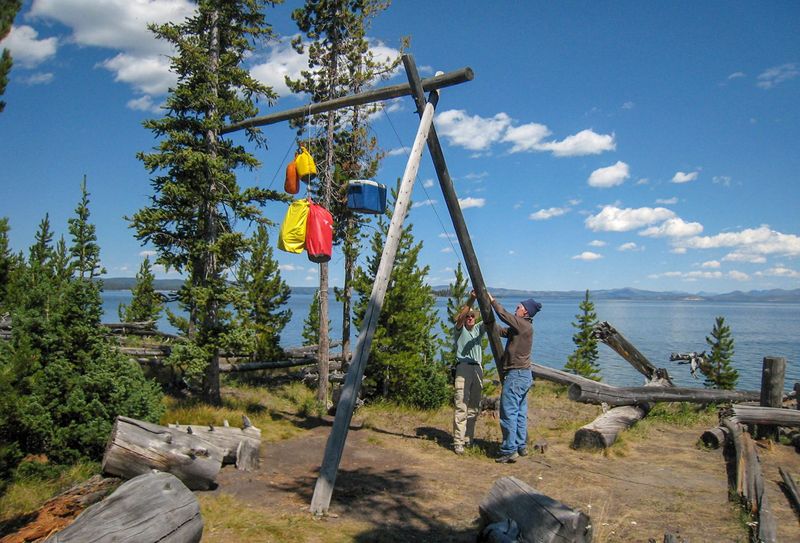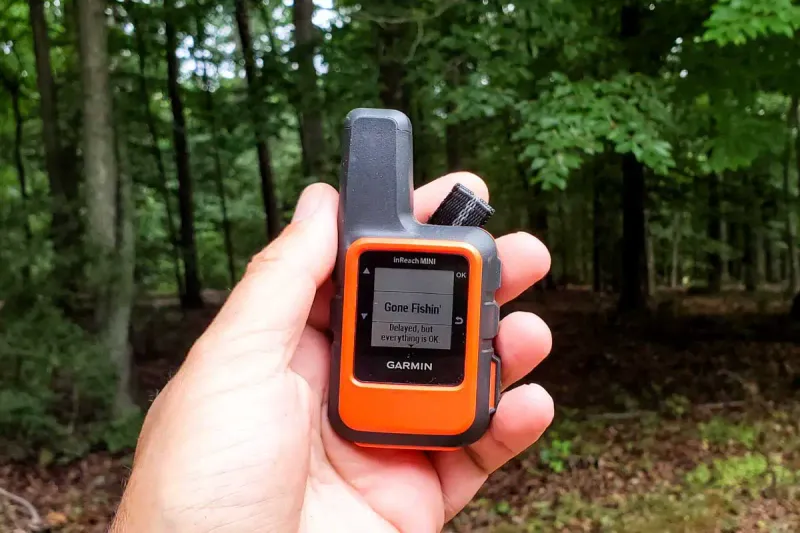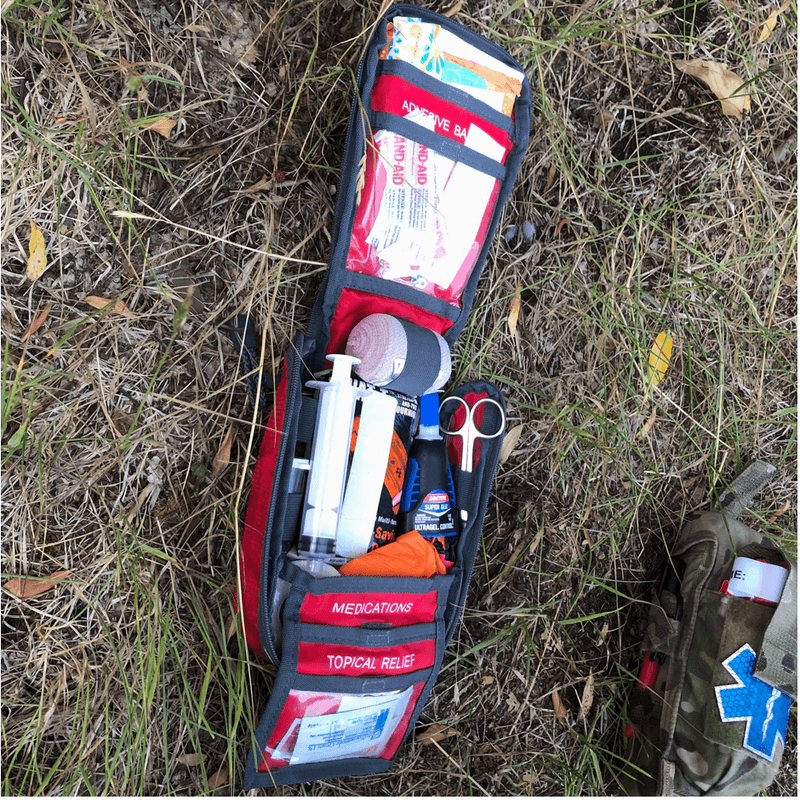Heading into bear country can be thrilling, but staying safe requires the right gear and know-how. Park rangers across North America have seen what works and what doesn’t when it comes to preventing dangerous encounters with bears. This guide covers the essential items they recommend carrying, storing food properly, and knowing how to respond if you cross paths with a bear on the trail.
1. EPA-approved bear spray (+ quick-draw holster)
Bear spray is your best defense if a bear charges, but only if you can reach it in seconds. Keeping it buried in your backpack is like locking your fire extinguisher in a closet. Rangers insist you wear it on your belt or chest strap where your hand can grab it instantly.
Make sure you buy EPA-approved bear spray, which is much stronger and sprays farther than regular pepper spray meant for people. The National Park Service recommends practicing with inert training cans so your muscles remember the motion. When adrenaline kicks in, you won’t have time to think—you’ll just react, and that practice could save your life in the critical seconds before a bear reaches you.
2. Inert training can (practice spray)
Would you try to use a parachute for the first time while falling? Of course not. The same logic applies to bear spray. An inert training can looks and feels like the real thing but sprays harmless air or water instead of irritating chemicals.
Rangers encourage everyone to practice removing the safety tab, aiming slightly down, and pressing the trigger before hitting the trail. Muscle memory matters when your heart is pounding and a bear is closing the distance. Practicing a few times in your backyard builds confidence and speed.
The National Park Service explicitly supports this kind of training because hesitation can cost you precious seconds during an encounter.
3. IGBC-certified hard bear canister
Hard-sided canisters are the gold standard when it comes to keeping your food away from bears overnight. These tough containers have been tested by the Interagency Grizzly Bear Committee and proven to withstand determined bears trying to crack them open. Popular models like BearVault BV series and Garcia 812 show up in nearly every backpacker’s kit.
Always double-check that your specific model appears on the current IGBC-approved list, because designs change and regulations vary by park. Some wilderness areas require canisters by law, and rangers can fine you if you skip this step.
A bear canister protects wildlife as much as it protects you, preventing bears from becoming food-conditioned and dangerous.
4. IGBC-certified soft sack (e.g., Ursack Major/AllMitey)—when allowed
Soft bear-resistant sacks offer a lighter alternative to bulky hard canisters, making them popular with ultralight backpackers counting every ounce. Brands like Ursack have earned IGBC certification by proving bears can’t rip them apart, even though they lack rigid walls. The catch? Not every park allows them.
Some areas with grizzly populations insist on hard canisters only, so you must verify local regulations before your trip. Rangers have seen too many hikers arrive with the wrong storage and face tough choices: buy or rent a canister, or turn around. Soft sacks work brilliantly where permitted, but doing your homework ahead of time saves major headaches on the trailhead.
5. Odor-barrier liners (for inside your canister/sack)
Even the toughest bear canister won’t help much if smells leak out and lure a curious bear to your camp. Odor-barrier liners add an extra layer of scent control by sealing in the aromas of your freeze-dried meals, energy bars, and snacks. Think of them as insurance inside your main storage container.
Manufacturers market these bags for their odor-blocking technology, but rangers stress they’re not bear-resistant on their own. You still need an approved canister or sack doing the heavy lifting. Combining both methods keeps your campsite less attractive to wildlife.
The National Park Service reminds hikers that reducing smells is part of a larger clean-camp strategy that protects both people and bears.
6. 50–100 ft throw line + carabiner (for hangs where legal)
In areas where food hangs are allowed or even required, a long throw line and sturdy carabiner become essential tools. The National Park Service specifies minimum clearances: about ten feet off the ground and four feet away from the trunk or branch. Getting a rope over a high limb takes practice, patience, and the right length of cordage.
Many parks have shifted toward requiring canisters instead of hangs because bears have learned to defeat poorly executed rope systems. Before you pack your throw line, confirm the local rules. Done correctly, a bear hang keeps food safe; done wrong, it becomes an all-you-can-eat buffet dangling in the trees for a clever bear.
7. Bear-resistant cooler (car/base-camp use)
Front-country camping brings different challenges than backpacking, but bears don’t care whether you’re in a tent or an RV. An IGBC-certified cooler protects your perishables and keeps your campsite compliant with park regulations. Many drive-in campgrounds provide metal food lockers, but if you’re dispersed camping or your site lacks one, a certified cooler is your next best option.
Check the latest IGBC list to verify your cooler model meets current standards, because older designs may no longer qualify. Rangers patrol campgrounds and can issue citations if your cooler isn’t up to code.
Keeping a clean camp with proper storage helps prevent bears from becoming habituated to human food, which ultimately keeps everyone safer.
8. Camp kitchen cleanup kit (strainer + sealable waste bags)
A tidy camp is a safe camp. Food scraps left in dishwater or scattered on the ground send an open invitation to bears, so rangers recommend straining every bit of graywater before disposal. A small mesh strainer catches pasta, rice, and other particles that you can seal in waste bags and pack out with your trash.
The National Park Service emphasizes that all scented items—soap, toothpaste, trash, even that half-eaten granola bar—must go into approved storage, not left lying around. Low-odor graywater can usually be scattered widely away from camp, but check specific park rules. Proper cleanup habits reduce the chance of nighttime visitors and help keep bears wild instead of conditioned to raid campsites for easy meals.
9. Portable electric bear fence (for remote basecamps)
In remote Alaskan basecamps and certain backcountry zones, a portable electric fence can be a game-changer. These lightweight systems create a perimeter around your tent or kitchen area, delivering a startling shock to any bear that touches the wire. When set up correctly, they’re highly effective deterrents that give you peace of mind in grizzly territory.
The Alaska Department of Fish and Game and the U.S. Forest Service offer detailed how-to guides and design specs approved by the IGBC. Electric fences require practice to deploy properly and aren’t foolproof, so never rely on one alone without also following proper food storage protocols. Used together, fencing and canisters create multiple layers of protection in the wildest places.
10. Air horn (secondary deterrent)
An air horn’s piercing blast can startle a bear and sometimes convince it to leave the area, especially if the animal hasn’t fully committed to an approach. Parks Canada and the National Park Service list air horns as useful secondary deterrents, but they come with a big caveat: no deterrent works 100 percent of the time. Some bears ignore loud noises entirely, and others may only pause briefly before continuing their investigation.
Rangers stress that deterrents like air horns should never replace proper food storage and maintaining distance. Think of an air horn as one more tool in your kit, not a magic wand. Avoidance and prevention remain your primary strategies for staying safe in bear country.
11. Binoculars/spotting scope
Watching a bear forage in a meadow or fish in a stream is one of the great thrills of wilderness travel, but only if you keep a safe distance. Binoculars or a spotting scope let you enjoy these moments without getting too close and stressing the animal. The National Park Service provides clear guidance: give bears plenty of space and never approach for a closer look or photo.
A good pair of binoculars turns a distant speck into a detailed wildlife encounter you’ll remember forever. Distance and awareness are key to prevention, and optical gear helps you spot bears early so you can adjust your route or wait for them to move on. Rangers see too many close calls from hikers who crowd wildlife for selfies.
12. Group-comms noisemakers (your voice, hand claps)—not just bells
Most bears want nothing to do with humans and will avoid you if they hear you coming. The problem is surprising a bear at close range in thick brush or around a blind corner. Making noise as you hike gives bears time to move off the trail before you arrive.
Rangers recommend talking, clapping, or calling out in areas with low visibility rather than relying on those little bear bells. Bells produce a faint jingle that doesn’t carry far, while your voice and hand claps create unmistakable human sounds. The National Park Service stresses this simple prevention tactic works best in groups, where natural conversation keeps a steady stream of noise going. Solo hikers should make a habit of calling out regularly, even if it feels silly at first.
13. Dedicated “smellables” tote
Bears have an incredible sense of smell, detecting scents from miles away. Toiletries, sunscreen, bug spray, trash, even that minty lip balm—all count as attractants that must be stored properly. The National Park Service is crystal clear: scented items belong with your food in approved storage, never in your tent, kayak, or car.
A dedicated tote or dry bag keeps all your smellables organized in one place so you don’t accidentally leave something out. At night, everything goes into your bear canister, locker, or hang. Rangers have responded to tent break-ins caused by a forgotten tube of toothpaste or a candy wrapper in a pocket. Following park directions for storage protects you and prevents bears from learning bad habits.
14. Map of local food-storage rules
Bear regulations aren’t one-size-fits-all. Some parks require hard canisters, others provide bear poles or metal lockers at designated sites, and a few allow certain soft sacks or hangs. Showing up without knowing the rules can derail your trip before it starts, leaving you scrambling to rent or buy approved gear at the last minute.
The National Park Service maintains detailed pages for each unit, outlining exactly what’s required and where. Print or download a copy before you leave home, and double-check for any recent updates or closures. Rangers appreciate hikers who do their homework and arrive prepared.
A little research goes a long way toward a smooth, safe adventure in bear country.
15. Trip plan + satellite communicator (SOS only if needed)
While not bear-specific, a solid trip plan and a satellite communicator can be lifesavers if something goes wrong deep in the backcountry. Tell a trusted friend or family member your route, campsites, and expected return date. If a bear encounter, injury, or sudden closure strands you, that information helps search-and-rescue teams find you fast.
Satellite communicators let you call for help when cell service is nonexistent, but they’re for true emergencies only—not checking social media or texting friends. The National Park Service emphasizes planning and reporting incidents as part of overall wilderness safety. Carrying a communicator adds peace of mind and ensures you can reach help if prevention and deterrents fail in a worst-case scenario.
16. First-aid kit (incl. wound care)
Bear attacks are extremely rare, but carrying a well-stocked first-aid kit is basic wilderness common sense. Include plenty of gauze, bandages, antiseptic, and supplies for treating serious wounds, not just blisters and scrapes. Know basic wound care, how to control bleeding, and when to call for evacuation.
Rangers stress that prevention—maintaining distance, proper food storage, and having bear spray ready—is your primary medical strategy. A first-aid kit is your backup for the unlikely event that everything else fails. The National Park Service safety pages emphasize planning and preparation, and a solid kit is part of that foundation.
Hopefully you’ll never need it for a bear encounter, but it’s essential for any backcountry emergency that might arise on the trail.





